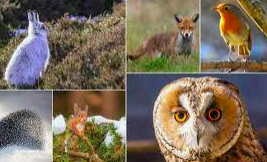A really fantastic way to get outside and learn about our countryside.
If you're not available for the workshops there are many ways you can encourage wildlife into your garden:
1. Put Up Nesting Boxes
Nesting boxes will encourage birds to breed in your garden. Different types of birds favour different types of boxes (see the further information links). Put up bird boxes where they are sheltered from the elements and install before spring so that you do not disrupt the breeding season.
2. Plant a Tree
Native trees will help attract birds and insects. Go for species like crab apple, conifers, silver birch, yew, alder, or if you have space for a large tree, try elm, beech or ash. Trees provide a nesting place for birds and squirrels, while if you want to attract bats, willow will give you the best chance. If you have space to plant a few trees near each other this will create more of a woodland habitat drawing a wider range of wildlife.
3. Grow a Hedge
Hedges provide additional nesting areas for birds and small animals. They also help to shelter the garden. Suitable hedge plants include blackthorn, buckthorn, cherry plum, elder, hawthorn, hazel and privet. Climbers and creepers provide further foliage to boost the insect population and draw birds. Clematis, dog rose and honeysuckle are traditional favourites.
4. Grow Wildflowers
Butterflies and bees are drawn to areas of wildflowers. Buddlea is a particular favourite of butterflies, and native species with an open structured flower are good for attracting bees.
Plants that are over-bred so that they have two flowers per stem will not provide much nectar or pollen so are best avoided. Cornflowers, floxgloves, bluebells, crocus and globe thistle are just a tiny selection of the plants you could choose to encourage wildlife.
5. Cultivate a Wilderness Area
Leave an area of wild lawn to mimic a meadow - enticing shrews, voles and other mammals that feed on grass or insects. A pile of dead wood will encourage beetles and grubs which will in turn draw larger foragers.
6. Hang a Bird Feeder
Hang a bird feeder filled with unsalted peanuts from a branch or get one which attaches to a window with a suction pad for a close-up view. You can get squirrel-proof bird feeders to ensure the squirrels don’t steal all the food, but hang an ordinary feeder alongside so that they don’t go hungry either. Fat balls and seed mixes are ideal for attracting a range of bird species. Offerings of bacon rind and grated cheese will also make you popular with your avian neighbours.
7. Erect a Bird Table and Bath
A bird table provides a useful feeding perch away from predators and a bird bath provides a water source for drinking and washing. Make sure your bird bath doesn’t freeze over in winter by pouring boiling water over it. If you have a cat, put a bell on its collar to prevent it from bringing home your carefully nurtured wildlife as an unwanted offering.
8. Attract Mammals
You can buy special feed for hedgehogs from garden suppliers, while badgers will eat unsalted nuts and seeds, fruit and root vegetables. Make sure you leave out water as well. Steer clear of bread and milk which cause digestive problems for animals. Offer a hedgehogs a safe place to hibernate in the winter by buying a hedgehog house.
9. Create a Water Feature or Pond
If you have space for a pond this will diversify your garden ecosystem, or if not, even a small water feature will help to attract different creatures. A pond allows you to keep fish and frogs as well as attracting beautiful insects like dragonflies. Use plants like water lilies and broad leaf pond weed to develop your underwater habitat.



